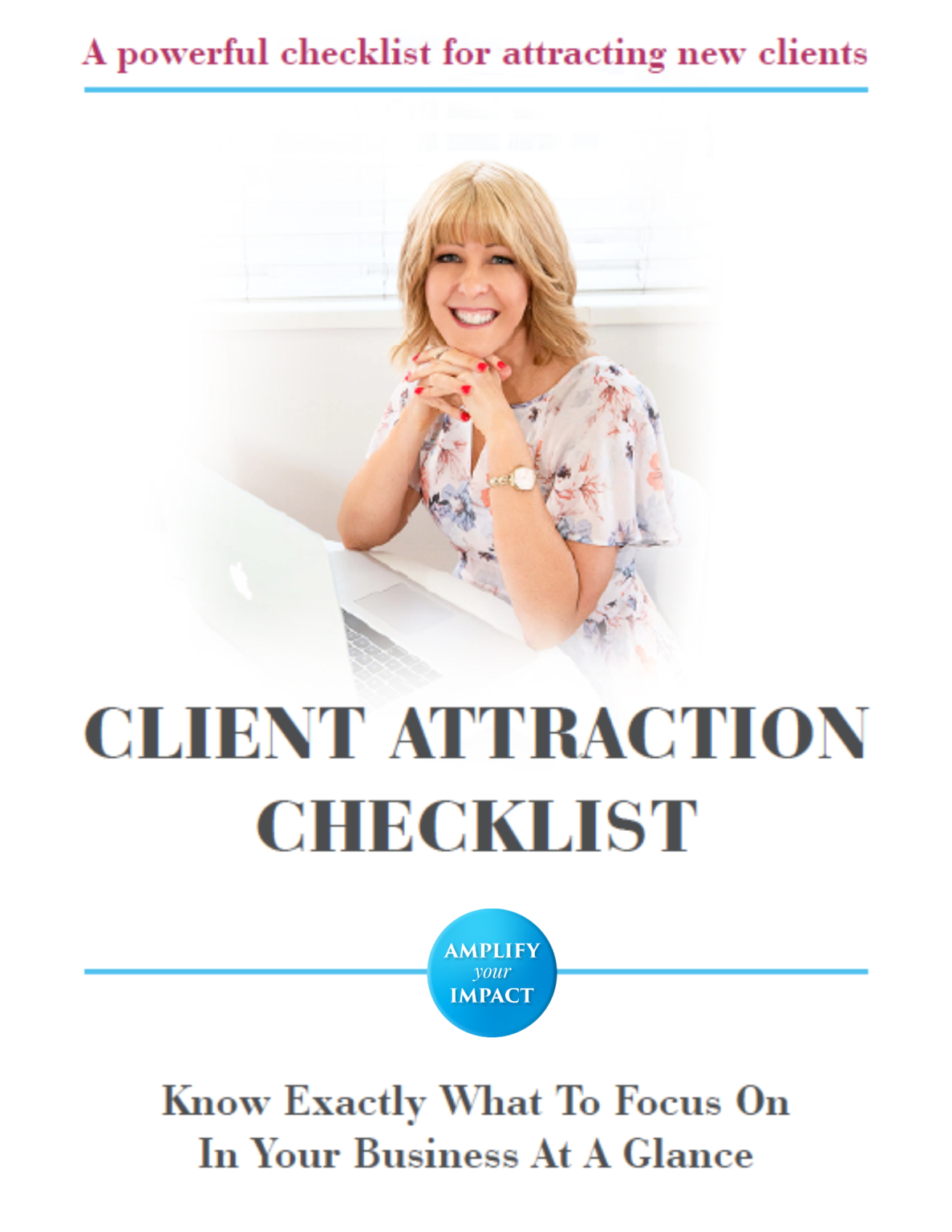Have you ever wondered what effect your personality style is having on how fast you’re growing your business?
A lot of people share with me that they struggle to do the things that successful business owners do, like holding an event, doing a Facebook live video, or running a webinar, and put it down to being an introvert.
Other times, extroverts tell me that normally they can talk to anyone – but when it comes to talking to that little lens on their laptop, they get anxious.
Too often, we use our personality type – such as being an introvert to STOP us from doing the very things we KNOW we need to do, so we can see the results we want.
The KEY to getting results quickly in your business is to be able to clearly see what is acting as a handbrake and stopping you from moving forward in your business…
It is always the story we’re telling ourselves. And it all begins with our thoughts.
Being able to identify the thoughts that hinder our actions, and ultimately our results, helps you BREAKTHROUGH your limitations…
…and into the business success you dream of.
The challenge is, most of us have no awareness of the thoughts that are causing the issues because they are happening at the unconscious level.
In this training, I share how being an introvert or extrovert affects how fast you’ll succeed in business…
so you can…
* Use your personality traits to your advantage
* Identify the thoughts and beliefs hindering you from getting results
* Step out of the slow lane and into the results fast lane TODAY
I share my TEAR Model – a success creation formula that enables you to quickly identify what you need to focus on to create success in your business.
Introvert or Extrovert?
Let’s start by thinking about whether you identify as an introvert or an extrovert. I have a lot of people talk to me about this, and they use one or the other, as a way of explaining their results or their actions.
Introverts and extroverts both have traits that can serve them, and traits that can hinder them. There are pros and cons for each. You may identify as an extrovert or an introvert, or you may not identify as either.
Perhaps you identify as an ambivert, which is someone who has qualities of growth. All of us identify with each area in some ways. Sometimes we love hanging out with people because we’re human and we’re social creatures.
An ambivert is not someone who sometimes likes being with people and sometimes doesn’t. How ambiverts are typically described, is that they can slip into either depending on their mood, their context and their goals.
Ambiverts have also been called outgoing introverts. I naturally identify as an introvert because I love spending lots of time by myself, compared to a lot of people.
A lot of people don’t realise that I’m an introvert. They assume because I’m a speaker and I’m constantly showing up on video and running events, that I’m an extrovert. I have high energy when I’m with a group, so people often assume that I’m an extrovert every day.
I’ve also heard it described sometimes as an anti-social extrovert. Naturally, these people are extroverted, but they need a lot of time to recharge, before and after socialising.
And then, they really need a lot of time by themselves to draw energy, but they still love connection and being social. It kind of comes down to the amount of time that you really want to be with other people and where you get your energy from.
Beliefs About Introverts And Extroverts
A lot of people tell me that they are introverts and therefore they struggle to put themselves out there on video or running webinars or doing Facebook Lives.
It was Carl Jung who advanced the theory on introverted and extroverted personality types. He defined introversion as inwardly directed psychic energy. We may assume that introverts are shyer and find it harder. We may assume that extroverts are more willing to put themselves out there and present themselves more boldly and confidently.

It used to be that extraversion was a strong predictor of who would become a leader. But this thought has been debunked somewhat.
In my experience, all personality types struggle if they don’t have the right thinking, regardless of whether they identify as an introvert or extrovert.
According to an article on Inc.com, psychologists had discovered that introverts do just as well in leadership roles. A lot of these stereotypes have been challenged in recent times. I’ve read a number of articles on introverts who are really successful leaders and entrepreneurs.
In the past, in Western society extraversion was really celebrated. The outgoing enthusiastic person often is thought to get more things done and may be known as a greater communicator. This is seen as an asset.
However, other articles show that the introvert / extrovert scale only represents about 20% of what they called the Big Five personality traits. And that is a lot more to a person than how much social stimulation they need.
And this is really what I’m wanting to drive through as a point here, is that your success rate in business has very little to do with whether you identify as an introvert or extrovert.
In my experience, over the last 17 years in business, I’ve met a lot of successful extroverts and a lot of successful introverts.
What is it that is actually determining our rate of success then?
I have created a formula for success. I call it the TEAR Model.
T – Thoughts
E – Emotions
A – Actions
R – Results
The TEAR model explains that our thoughts lead to our emotions. Our emotions lead to our actions. And our actions lead to our results.
This is basic psychology. I didn’t make that up. I just gave it a label.
I just named a concept from everything that I’ve looked at in psychology from NLP to fixed mindsets and growth mindsets and cognitive behaviour therapy.
 Our results are based on our actions, our actions are based on our feelings and all of it is coming from our thinking and the stories that we tell ourselves. These stories include how we think about ourselves.
Our results are based on our actions, our actions are based on our feelings and all of it is coming from our thinking and the stories that we tell ourselves. These stories include how we think about ourselves.
Our self-image is made up of the stories that we tell ourselves. It’s made up of the beliefs, thoughts, and data or proof that we’ve collected over time. This all contributes to our story that we rehearse. But these stories are just thoughts.
So if we want to change our results, we need to look at what thoughts are driving those results. Most people are stuck at the results level, and asking themselves why they can’t get more results.
Everything that has been created has started with a thought. For example, a bookshelf. Someone had the thought to build a bookshelf. They got a feeling from that thought, whether it was a feeling of motivation creation, innovation, whatever it was. They took action and they created a result, which is the finished bookshelf.
Our thoughts are habits and you can create new thought habits. Instead of saying, “I’m an introvert, so I find it hard.” Choose a more empowering thought.
There are so many successful introverts. If you look at the Top 10 richest people in the world, who are multi-billionaires, like Jeff Bezos, Warren Buffett, and Bill Gates – about half the lists are introverts and the other half are extroverts.
These introverts are still putting themselves out there and not letting their introverted natures stop them from succeeding. Richard Branson is an introvert that sits on a couch and is kind of shy. He looks a little bit awkward. I’ve seen him live. He may be an introvert, but he’s presenting all the time.
Mark Zuckerberg, Steve Wozniak the co-founder of Apple, and Barack Obama, are all people who identify as introverts, and these people still present. A lot of them present regularly, and they don’t let being an introvert stop them.
If you want to succeed in business, your rate of growth is measured by how willing you are to take the right action, regardless of how you were born and what natural personality type you are.
Reverse Engineering the TEAR Model
When you look at the TEAR Model, and you say you want to get your business going fast, and you want to make money, help people and be creative. Perhaps you want to create an online course or a webinar or a coaching group program.
Grab a piece of paper and write down your page T.E.A.R. Start at the bottom with R.
R – Results
In the R line – put the result you want. Maybe the result is to make $10,000 a month or run a webinar, whatever your result is you are aiming for.
A – Actions
Then in the A line, you need to write all the different actions you need to take, to get to the result. It could be you need to create a free downloadable recourse or create a landing page and funnel. There are so many different lead generation strategies, and you just need to pick them and go for it for the next 30 days.
E – Emotion
In the E line, you need to write what emotions you need to have to take those actions. So you don’t want to be depressed, anxious, fearful, or stressed. What you want is to be determined and motivated.
You want to have the feeling of energy, that you’re unstoppable. Think about the emotion that’s going to make you want to take those actions and just write all those emotions out.
The emotion could be feeling unstoppable, or feeling passionate or grateful. These are the emotions that will drive you to take action.
T – Thoughts
Finally, what thoughts do you need to think? Thoughts are a little bit sneaky, as it’s harder to catch thoughts. What thoughts do you need to be thinking to get those feelings, take those actions and get that result?
With the thoughts, often you need to write them out or you need to go through them with a coach. Because for us to change, we have to change the meaning we put on things.
If we’ve been looking at something the same way the whole time, it’s really hard for us to see and have a different perspective on that thing. We often need someone else to give us a different perspective.
For example, if I hold up my phone. I’m looking at the Apple logo and you’re looking at the face of my screen. We’re both looking at the same object. But I’m looking at it from a completely different angle to you. I can only see this side of it, and you can only see the other side of it.
It’s the same with a result. We look at it one way. And there could be hundreds, if not thousands of ways to look at it. It’s very hard for us to try and do it in our mind.
We need to externalize it, and get it down on paper and do some self-coaching on it. This will help us get a little bit further than keeping it in our head. But ultimately, if you want to see a transformation, you need someone else’s perspective.
You need someone else to see things or draw things out of you, that were previously unconscious. About 90% of our thoughts we think every day are unconscious thoughts, and we are not even aware we are having those thoughts.
Your Thoughts Drive Your Results
It’s those unconscious thoughts that are driving our results. So, we can also sit down and think about the results we want, and what you might need to be thinking to get that.
One thought is: “Whatever it takes, I have everything I need to succeed.” How often are you repeating a thought like that in your mind, if you really want that desired result?
 How often are you having these commands that are going to get you that result? “I absolutely can create 10k a month as a business owner, and I will keep going until I find a way.”
How often are you having these commands that are going to get you that result? “I absolutely can create 10k a month as a business owner, and I will keep going until I find a way.”
If we thought that empowering thought dozens and dozens and dozens of times every day, and we felt the emotion of it, eventually we would start taking the actions and start getting the results.
Most people are focusing on the problems and all the reasons why things won’t work. They are focusing on the things that are going to give them a completely different result.
Using The TEAR Model On Current Results
So let’s look at the other side of it, and look at what your current results are. On the other side of the paper to your TEAR, write down your current situation. And this is where you can start reverse-engineering the thoughts that are driving your current results. It sounds simple but it is actually not.
It takes thinking and intention to really get to know what those subconscious thoughts are. To do this, look at your results. Let’s say you are only making $1,000 a month. That’s your current result.
Then ask yourself what actions you are taking that are leading you to the $1000 a month. It could be that you are contacting five people a month. Or you are doing Facebook Live once every three weeks. You may be reaching out to your email list once a month. These are all the actions you are taking to cause your current result.
Then write what feelings are driving these actions. Are you feeling negative about yourself? What do you say to yourself?
Are you saying to yourself, “I don’t really think I know what I’m doing? I’m kind of a bit vague. I don’t really trust myself. I don’t have a specific niche, so I’m coming from a place of doubt. I don’t want to turn up on camera so I’m avoiding running a webinar.”
There are so much fear and negativity attached to these feelings and all of these thoughts are negative, so these are leading to your wishy-washy results. You’re not putting yourself out there and showing yourself boldly.
Footpath Activities Versus Fast Lane Activities
I give an analogy of footpath activities, steady lane activities, medium lane, and fast lane activities.
Negative, pessimistic thoughts zap your energy. There is a flatness that comes with resignation. Instead of working on what you need to work on, you watch Netflix and don’t do what I call ‘fast lane’ activities. Fast Lane activities are what get you in the fast lane and get results fast.
 Fast lane activities are: directly contacting people, sales calls, and private messages.
Fast lane activities are: directly contacting people, sales calls, and private messages.
Medium lane activities include: following up leads, creating a webinar, creating a client attraction funnel, creating consistent content.
Steady lane activities include sending a weekly or twice weekly email to your list and updating your Facebook group regularly or posting really valuable content.
Footpath activities include: mucking around on Canva and trying to make things look pretty. Creating things that you don’t really need to create. Consuming a whole heap of content that is not needed but it’s fun.
If you look at your results, and your actions, you will probably find that you’re not getting the results you want, like the 10k a month, then you’re probably doing a lot of these footpath activities.
Think about the feelings, the doubt, the fear, and what thoughts are causing this result? “I don’t know what I’m doing. I don’t really know what I’m doing. Nothing works for me. Facebook’s too hard to figure out. I suck at technology.”
These thoughts are keeping you on the footpath and out of the fast lane. The TEAR Model is super easy, but it’s powerful to work out what you need to think, feel and take action on, to create the result you want. I encourage you to do this activity.
Do you need an external perspective on issues you are struggling with in your business? Are you finding it hard to unpack them and need to see your business blind spots?
Please get in touch with me. I give free strategy sessions for people who have not had one before with me.
You can book a strategy session with me here.
See you soon,
Kat
 When I’m 75, I don’t want to be retired. I still want to be writing, speaking, and taking more of an advisory role in my business. I want to be on the board of advisors for my company, and have a CEO looking after the day-to-day operations.
When I’m 75, I don’t want to be retired. I still want to be writing, speaking, and taking more of an advisory role in my business. I want to be on the board of advisors for my company, and have a CEO looking after the day-to-day operations. I was sharing in my Inner Circle group today about putting the accelerator on and choosing to stop cruising. How much time are you spending in the fast lane really accelerating your growth by facing the stuff that scares you?
I was sharing in my Inner Circle group today about putting the accelerator on and choosing to stop cruising. How much time are you spending in the fast lane really accelerating your growth by facing the stuff that scares you? We’ve all got a next level to go to.
We’ve all got a next level to go to. Look at what is on your walls and what kind of books you read. If you look at your audible account, what kind of books are in there?
Look at what is on your walls and what kind of books you read. If you look at your audible account, what kind of books are in there?
 A really compelling USP should be memorable. And it should be specific and tangible. It shouldn’t be, “We deliver fast service” or “We have a high-quality service.” That’s very vague and general.
A really compelling USP should be memorable. And it should be specific and tangible. It shouldn’t be, “We deliver fast service” or “We have a high-quality service.” That’s very vague and general. What are the things that you can do easily, that come effortlessly to you because you’ve done it for so long? This is part of your unique brilliance and your genius zone.
What are the things that you can do easily, that come effortlessly to you because you’ve done it for so long? This is part of your unique brilliance and your genius zone. So think about the work you’ve done in the past 10 or so years. My background is as a weight loss coach and personal trainer, so now a lot of my clients are in wellness and it’s part of my USP.
So think about the work you’ve done in the past 10 or so years. My background is as a weight loss coach and personal trainer, so now a lot of my clients are in wellness and it’s part of my USP. So you might think about what your program looks like in terms of the level of support you give. You may want to do daily texts for people.
So you might think about what your program looks like in terms of the level of support you give. You may want to do daily texts for people. Give an outcome in your promise. An example is, “If you follow these steps, you will get this outcome.” Or it could be, “If you follow this formula, you will get this result.”
Give an outcome in your promise. An example is, “If you follow these steps, you will get this outcome.” Or it could be, “If you follow this formula, you will get this result.” Your combination of stories and experiences really makes up your USP. If you’re 45-years old, you’ve got 5 decades to draw from. That’s 15 stories you could have.
Your combination of stories and experiences really makes up your USP. If you’re 45-years old, you’ve got 5 decades to draw from. That’s 15 stories you could have.
 Marketing is about targeting the right people and being willing to not attract everyone. Leaders and influencers are not afraid to repel some people, when the right people are drawn to them.
Marketing is about targeting the right people and being willing to not attract everyone. Leaders and influencers are not afraid to repel some people, when the right people are drawn to them. If you want to have compelling copywriting, you want to have a good balance of strength and warmth. Take the time to assess yourself and ask yourself where you sit on the strength and warmth spectrum. Even ask some people close to you for how they experience you to be.
If you want to have compelling copywriting, you want to have a good balance of strength and warmth. Take the time to assess yourself and ask yourself where you sit on the strength and warmth spectrum. Even ask some people close to you for how they experience you to be. It’s inspiring people to act. That is what valuable content is. Valuable content is not ‘3 tips’ or ‘3 secrets’ or ‘3 methods’.
It’s inspiring people to act. That is what valuable content is. Valuable content is not ‘3 tips’ or ‘3 secrets’ or ‘3 methods’. We can’t ignore this truth.
We can’t ignore this truth. These 7 things are triggers that people will take action to avoid.
These 7 things are triggers that people will take action to avoid. A really compelling post can make you a lot of money.
A really compelling post can make you a lot of money.
 When you name things and make them a formula, a roadmap, a blueprint, a method or pillars, you’re organising your knowledge and you’re putting a framework around it.
When you name things and make them a formula, a roadmap, a blueprint, a method or pillars, you’re organising your knowledge and you’re putting a framework around it.